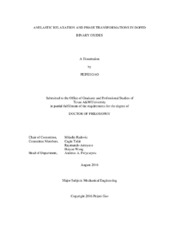| dc.description.abstract | Doped binary oxides (DBOs) with fluorite structures, such as doped ceria (CeO2) or zirconia (ZrO2), are widely used in different electrochemical devices such as solid oxide fuel cells, oxygen sensors, and gas separation membranes due to their high ionic conductivity. Mechanical and electrochemical properties of DBOs and their eventual coupling are of crucial importance for their use in different electrochemical devices commonly operating under harsh environments including high temperature, mechanical stress, electrical field, and reducing/oxidizing environments, etc. In this study, we report on the temperature-dependent mechanical and electro-mechanical properties of common electrolyte materials such as yttria-stabilized zirconia (YSZ), scandia-ceria-stabilized zirconia (SCSZ), and gadolinia-doped ceria (GDC).
The mechanical properties were studied using resonant ultrasound spectroscopy (RUS), dynamic mechanical analysis (DMA) and cyclic compression testing (CCT). In addition, in-situ neutron diffraction at elevated temperatures was used to study structural changes under applied mechanical loads in the case of YSZ. It was found that the elastic moduli change with temperature in a non-linear manner, where the large decrease in elastic moduli with temperature and large mechanical loss (or mechanical damping) occur in different temperature ranges (~100–500ºC) for stabilized zirconia ceramics with different dopants and compositions. In addition, a slight deviation from the linear change of elastic moduli with temperature and a much smaller mechanical damping was observed in the temperature range of 100–300ºC for doped ceria ceramics, when compared to stabilized zirconias. Furthermore, stress-strain hysteresis loops (pseudoelastic behavior) were observed in YSZ and SCSZ under sinusoidal compressive loading at different temperatures. It is shown in this study that the non-linear changes of elastic modulus with temperature and stress-strain hysteresis can be attributed to the following mechanisms: (i) stress-induced reorientation of oxygen vacancy complexes in all materials and (ii) reversible phase transformations in SCSZ.
In addition, electro-mechanical coupling in stabilized zirconias with centrosymmetric cubic (fluorite) structure was studied. It was found for the first time that both YSZ and SCSZ undergo spontaneous polarization under sinusoidal stress, suggesting their piezoelectric behavior. Stress-induced polarization was observed in YSZ in the 210–570 ºC temperature range while in SCSZ it occurs between 200ºC and 300ºC. These results suggest that the reorientation of oxygen vacancy complexes may be the reason for electro-mechanical coupling. Although the magnitude of polarization in 8YSZ was found to be smaller than that in traditional piezoelectric materials such as PZT, it is still significant especially because it was measured at temperatures significantly higher than Curie temperature in common piezoelectric materials such as PZT. | en |


